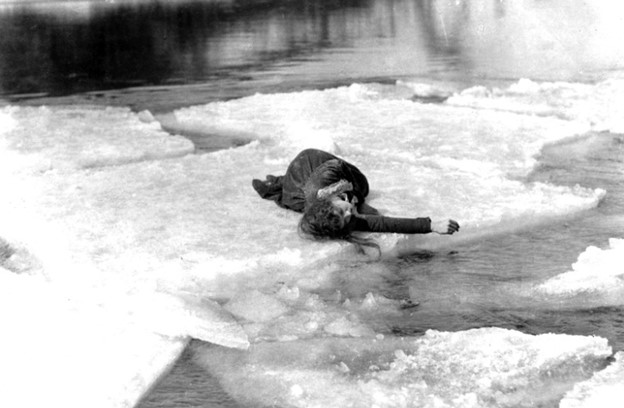Way Down East (1920)
D.W. Griffith's "Way Down East"
In 1920, D.W. Griffith adapted the well-known 19th-century play Way Down East by Lottie Blair Parker into a film. The play had been one of the most popular productions in the United States, but by 1920, it was considered outdated, having toured from 1897 to 1909. Because of this, many, including lead actress Lillian Gish, thought Griffith was making a mistake by adapting it. The play’s outdated nature was also due to its old-fashioned Victorian-era ideas. However, under Griffith's direction, the adaptation became a rousing success.
Lillian Gish plays Anna, a poor country girl who is tricked into a fake wedding by the womanizing Lennox. When she becomes pregnant, he abandons her. After the baby’s death, Anna wanders onto the farm of a local family, who take her in as a house servant. To her surprise, Lennox appears, lusting after one of the family’s daughters. When town gossip exposes Anna’s past, she is asked to leave the family home. Before she departs, she reveals that Lennox is the cause of her troubles. After running off into a snowstorm, David, a member of the family who is in love with Anna, goes after her and eventually rescues her from an icy fate.
Griffith, alongside his technical innovations, has fully developed his visual style by relying on the performances of his actors. Accustomed to grand, epic scales in his earlier productions, Griffith began, in the years leading up to 1920, to focus more on intimacy in his films. To achieve this, he used broad gestures, intense close-ups, and fluttering eyes to capture the emotional depth of his characters. Long takes also play a key role, allowing the viewer to truly sit with and understand the emotional landscape, which enriches the film-watching experience. Rather than focusing solely on grand social ideals, the familiarity that viewers feel with the characters fosters a stronger sense of empathy. This is especially important in Way Down East, where it is crucial for the audience to identify with Anna in order to reject the Victorian pressures placed upon her. Anna is portrayed as a victim throughout the film, and without the ability to connect with her, the audience might feel she deserves her fate. However, stepping into her shoes enables the viewer to more effectively analyze the oppressive societal structures surrounding her.
Way Down East is perhaps best known for its climactic ice rescue. Due to the primitive nature of capturing authentic representations on film during the 1920s, the scene had to be shot in an actual blizzard. No stunt double was used, as Lillian Gish had to lie still on a constructed piece of ice as it moved down a frozen river. It was also Gish's idea to wet her hair to make the scene appear more realistic. The effect remains one of the greatest shots in cinematic history (below).
Such sequences are commonplace in contemporary films. Many modern viewers would recognize the rhythm of shots used to depict someone trapped on a river, heading toward an imminent waterfall. The visual juggling of the trapped individual, their movements in the water, wide shots of the surrounding environment, and the medium shot of the approaching waterfall is a common directorial technique designed to create thrilling anticipation of impending danger. However, for moviegoers in 1920, these rhythmic shots really got their legs jumping.
For the director and film star, the effect was everlasting. Gish reportedly suffered damage to her right hand, losing partial feeling in it for the rest of her life. Griffith was also frostbitten on one side of his face. Despite the injuries to the crew, a cinematic moment was captured forever.
Taking a Victorian-era play and debuting it in front of a 1920s audience was a risky decision, especially given the high cost of production. The $175,000 budget for the film was more than the cost of Griffith's The Birth of a Nation five years earlier. Despite the outdated material and expensive enterprise, the film's earnings were explosive. With a national gross of over $4.5 million, Way Down East became the fourth-highest-grossing silent film in history. With this film, D.W. Griffith cemented his visual style forever.
Through his earlier works, Griffith had created a basic formula for how film should be expressed, forever changing the medium. By 1920, the visual format of storytelling had been established, thanks in large part to Griffith. However, it was this very established visual style and foundational framework that would contribute to his decline. Way Down East was the last major success he ever had. Despite Orphans of the Storm a year later, the syntax of cinema that Griffith had pioneered began to feel outdated by the mid to late 1920s. His once-revolutionary innovations became so basic and commonplace, so ingrained in the standard of filmmaking, that his continued work began to feel antiquated as the 1920s saw further innovations through German Expressionism and Soviet Montage.
Way Down East marked the last time audiences flocked to cinemas nationwide to experience Griffith's invention of film, as the visual language he pioneered became ubiquitous.




Comments
Post a Comment